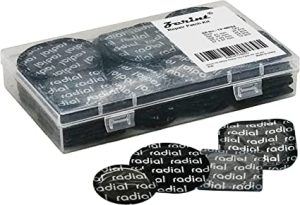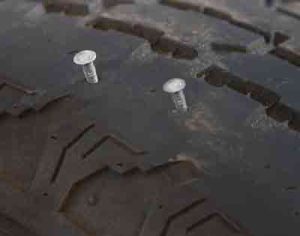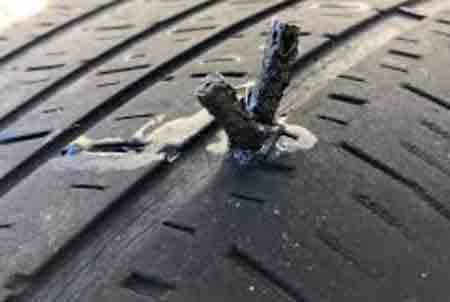A plug will help you fix a puncture and you can inflate the tire. As good as that might seem, it will not address any damage that happens on the sidewall or inner walls.
You can make use of a plug without having to remove the tires. This could, however, mean that there is a possibility that interior damage could have happened which could lead to the failure of the tire at a later date.
A patch used on the interior of the tire will fix the damage in this region however, the outer region could still be exposed to air and moisture penetration.
This could lead to separation of the treads causing the steel belts to corrode. As a result, a punctured tire must be well inspected inside and outside. The tire must even be detached from the rim for proper examination.
Can a Plugged Tire be Patched? The best repair solution is using both the patch and plug together. So, yes, a plugged tire can be patched and it is safer than using a patch or plug alone.

Once you locate the puncture in your tire, you can insert a plug from the inner parts of the tire. You can then add a vulcanizing cement and a patch to further protect the tire.
Table of Contents
What to Check before Patching your Plugged Tire?
Combining a patch and a plug involves using a repair patch with a rubber plug inserted to the center of the patch and a plug.
- Locate the position of the puncture
- Ream it out for a clean hole
- Add vulcanizing cement to the area of the hole
- Pull the plug from the outside area of the tire through the reamed hole
Locate the position of the puncture
So, in the repair process, you must first locate the position of the puncture. Locating the puncture could be a little tricky process. It could sometimes be as easy as locating a nail or screw in the tire.
Other times, you might have to make use of a cleaner that bubbles. You should pour the cleaner down the tread and try to notice where it bubbles.
The region where the bubbles are coming out from is where the puncture is located and make sure to mark that spot.
Ream it out for a clean hole
Then, you should ream it out to create a clean hole for the plug. You can clean the hole of the puncture using an air dire grinder.
The grinder also helps to make the inside of the puncture a bit coarse. You must then go ahead to prepare the region around the puncture on the inside of the tire to help to bond with the patch.
Compressed air can help make sure that there is no more debris around the area of the puncture.
Add vulcanizing cement to the area of the hole
Add vulcanizing cement to the affected area and also to the plug and patch combination.
Pull the plug from the outside area of the tire through the hole you have reamed
This will help to make the plug fill the hole and create a proper seal with the tire’s rubber.
This also allows the patch to bond to the inside region of the tire and as such, prevents air escape.
The plug seals the hole created by the puncture making it difficult for moisture and air to penetrate the tire.
Their combination seals the fracture area. Trim the rubber stem to ensure that it corresponds with the surrounding tread.
The cost of this combination outweighs using either the patch or plug alone but it is a safer solution.
Using either of those repair methods alone could seem like an ideal solution but in the long run, it could come back to haunt you. So, the best practice is to use the two of them together.
When Can a Tire Not Be Patched?
The region where the puncture of your tire has occurred goes a long way to determine whether the tire can be patched or you have to replace the tire.
You can actually opt for a repair if your tire meets any of the following conditions:
It has been punctured by a small object
Small objects don’t cause much havoc to your tire as they generally create small holes in the tire which results in a slow puncture.
Even though they do not cause any serious damage, you must make sure you get them fixed immediately. Slow punctures can eventually result in a blowout especially when your vehicle runs at a high speed and this can put lives and properties at risk.
The puncture is less than 5mm in diameter
As this is a considerably small puncture, it can be easily repaired and you can get your vehicle back on the road in no time at all.
The puncture took place in the central position of the tread
A basic rule of thumb is the fact that so long as the puncture in the tire occurs in the shoulders, then a repair with a patch is very possible.
So, in what conditions should I not opt for patching that punctured tire?
Whether it occurs in your first few hours of driving or after traveling a long distance, a cut or puncture might have you replace the tires instead of repairing them.
The first consideration to knowing whether you can patch a tire is how quickly you can discover the damage and how fast you can respond to it.
The early discovery and swift response can go a long way to determine if a patch can still be used on the said tire.
Tires actually need a certain inflation pressure to be able to support the load of the vehicle, so you must make sure you don’t drive on a flat tire.
Even though the flat tire can give you prolonged mobility, you might not be able to return it to a good condition after you have driven with it.
How you will know a tire that has been driven when it was flat or that is low on pressure is that you will see some scuffing on the inboard and the outboard of the tire’s sidewall.
So, repairing the tire without detaching it from the rim can be short-lived as we have earlier established. If you do not dismount the tire, you will most likely miss the hidden damages.
Another consideration is to check out the location, size, and what kind of puncture your tire has suffered.
The guidelines allow you to patch punctures of ¼” in diameter that occurs in the tread area. Some manufacturers limit the number of repairs that you can have, most times that comes down to two repairs.
Some manufacturers even give you how close those repairs should be, at least 16” apart. Patching punctures in the shoulder or sidewall is not really advisable.
Larger punctures in the tread, irregular gashes, and long straight cuts are also not to be patched. Long cuts usually would have sliced through the steel belts of the tire reducing its strength and durability.
Although damage to your tire can be inconvenient, making use of a tire that has not been adequately repaired can cause some serious issues. If you have any doubts, make sure to replace the tires instead of using a faulty one.
Can You Patch a Tire with 2 Nails In It?

You might be able to drive a short distance with nails in your tire but you must make sure you remove them.
In fact, the best practice is to remove the nails the moment you notice them. Driving with a nail in your tire is not safe at all, two nails are more dangerous.
The first thing you must do is to ascertain the depth of the nails before doing anything. Many times, the nail can be easy to spot, other times, you might have to make use of a bubbly solution.
The location where the bubbles are coming out from is where the nails are located.
So, you can actually patch your tire with two nails in it.
We will however recommend that you use the patch and plug combination that we have outlined earlier as it is safer.
Although, in this scenario, if you want to keep your tire in good condition, you should visit a technician and have them do it professionally.
Doing it on your own is only a temporary solution and could cause more damages than you intended it to.
Can I Drive Long Distance on a Patched Tire?
Yes, you can drive a long distance on a patched tire.
A quality patch and plug tire kit that is well installed according to the guidelines laid down by the manufacturer can actually last the lifetime of the tire.
This repair can either be done by a professional or you could do it yourself. You should be able to use the tires as though nothing ever happened to the tires at all.
This properly installed patched tire will hold pressure for the entire lifetime of the tire.
There are some important things worthy of note though:
- For the recent version of tires, the patch must be inside the tread belt package. Some years back, you could move further into the shoulder of the tire but in recent times, the tread belt is the narrow bit.
- The diameter of the puncture must not be more than ¼”. If it is larger, the manufacturers will no longer feel at ease to stick to their warranties.
- The best practice is to use an entire repair kit from the same manufacturer. The manufacturers make their products work hand in hand. So, you stand a risk of compatibility if you mash up several products from several manufacturers.
- Desist from patching the shoulders or sidewall. Patching is not a repair system that can hold such regions firmly especially when the vehicle is in high speed during motion.
- Do not patch an area that has been patched already. Overlapping patches is not something recommended by any manufacturer at all. Your best bet is to replace the tires in such conditions.
How long you can drive on a patched tire also depends on the number of times that you have patched the tire in question.
According to top professionals, you should never retread a particular tire more than three times. So, the tire will last for long if you take proper care of the tire and have good maintenance culture.
You must also ensure you don’t put the tires through harsh conditions of overspeeding. So, if you love driving at high speed, it is best you replace the tires as the damage to the patched tire could be fatal.
The experience could also count for a lot when patching the tires. If a very experienced or skilled person patches a tire, you should expect that such a tire will last long.
Even though, there’s nothing terrible about you fixing the patch, your skill in doing that cannot be compared to that of an experienced professional.
Conclusion
Patching could give your tires a new lease of life and they are more economical than replacing the tires entirely.
It could also come in handy as a lifesaver in cases of emergency resulting from blowouts or punctures. A patching kit is cost-effective as you can easily recoup the money.
However, it is not in every puncture scenario that you must patch the tires. Sometimes, what is best for the tire is to be replaced as we have highlighted.
We have also shown you have you can successfully patch your plugged tires. If done properly, it could save your tire from severe damage. The combination is also safer and well recommended.
Ensure you stick to our guidelines and your tires will certainly be in good working condition.
Related articles:
- Bike Tire Patch Glue Substitutes You Should Know
- Can You Patch A Tire After Using Fix-a-Flat
- Rubber Cement Alternatives for Tires
- Is Rubber Cement Same as Vulcanizing Cement

